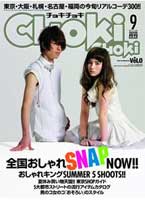Web Japan > Trends in Japan > Fashion > "Salon Boys" Set The Trend
"Salon Boys" Set The Trend
Fashionable Hairdressers Inspire Their Own Style
Japanese men's fashion encompasses many distinct styles, ranging from designer-brand slaves to gyaru-o ("gal men"), meaning male versions of the dyed-brown-haired Shibuya "gals" who dress in tight T-shirts and ripped jeans. There are also the sporty "street style" men who favor sweats and sneakers. But currently the undisputed trendsetters are the "salon boys"—professional or apprentice hair stylists in their late teens and twenties. Their major turf is Harajuku, Tokyo's premier hair salon battleground. Known not only for sporting the very latest hairstyles, as one would expect of their profession, but also for mixing designer brands with vintage and second-hand clothes, they pay attention to the smallest items, including hats, glasses, belts and shoes.
The Roots of Salon Boys
It all started with the 1999 cult TV series Scissors League, which chronicled the lives of artistically and technically gifted hair stylists. The series is credited with setting off the craze for so-called charisma hairdressers, who became regular fixtures on TV and in magazines not only for their hair styling skills but also for their choices of fashion, cars, bikes, and interior design. The exposure of their charismatic figures also turned hair styling into a popular career choice for young men.
Although this craze has gone down, the salon boys have remained an object of emulation for many young men, in part thanks to the launch in 2002 of the magazine CHOKi CHOKi ("Snip Snip"), which features real-life hair stylists as models. Today, the term salon style refers to professional and apprentice hair stylists' fashion and to those who have adopted their style.
Behind the Boom
What is behind the boom in salon style? Keeping up with and setting fashion trends is a professional necessity for salon boys. Clients expect their hair stylist to adopt, model, and advise on the latest trends. And the salon boys' metrosexual style has proven to be popular with both men and women. Salon boys are credited with launching unisex trends symbolized by fedora hats, narrow ties, and long cardigans. (September 2008)



